Existing User Log In
New User Registration
Register for a free account to gain full access to the VGChartz Network and join our thriving community.



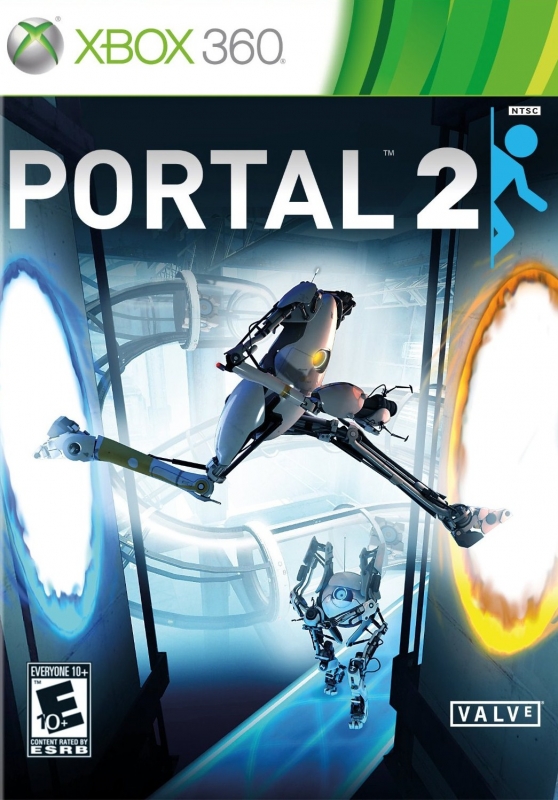

America - Front
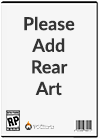

America - Back

The original Portal came at most gamers from nowhere. It was based on a student game called Narbacular Drop which used portals to solve puzzles. Valve first released Portal as part of The Orange Box in 2007. It was a fun, quirky, and hilarious little puzzle game with only 19 test rooms followed by a climactic escape and battle with GLaDOS, the facility’s sardonic, HAL 9000-like AI computer.
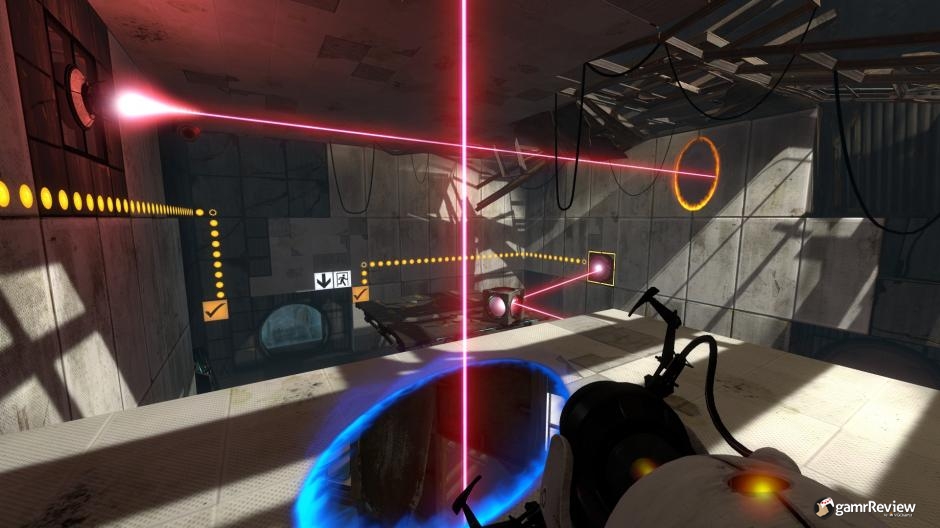
Now comes Portal 2, Valve’s big-budget, long development sequel to the original cult hit. You find yourself awakened by a moronic but lovable computer AI called Wheatley. The Aperture Science facility is crumbling and he’s trying to save you. After you bumble around learning how to use the portal gun, Wheatley’s ineptitude reboots GLaDOS, who is none too happy that her murderer is running around alive and well.
The basic gameplay mechanics of Portal remain. The portal gun will fire two portals which connect to each other. Walking through one will make you exit out the other. This sounds simple at first, but just like in the first game, things like momentum start to complicate the test rooms into mind-bending puzzles. Another familiar mechanic is the cube. Often, puzzles require you to find a cube to place on a button to keep a door open, utilizing portals to get said cube from point A to point B.
There are quite a few new mechanics to make Portal 2 a more complex game. Mirror cubes are your first new tools, which can be used to redirect lasers which can be used to open doors with laser receptacles and can also be used to destroy turrets that will shoot you if they can see you. Hard light bridges are more new tools in your toolbox. These bridges can be redirected using portals to allow you to reach different places around the room or block the view of turrets.
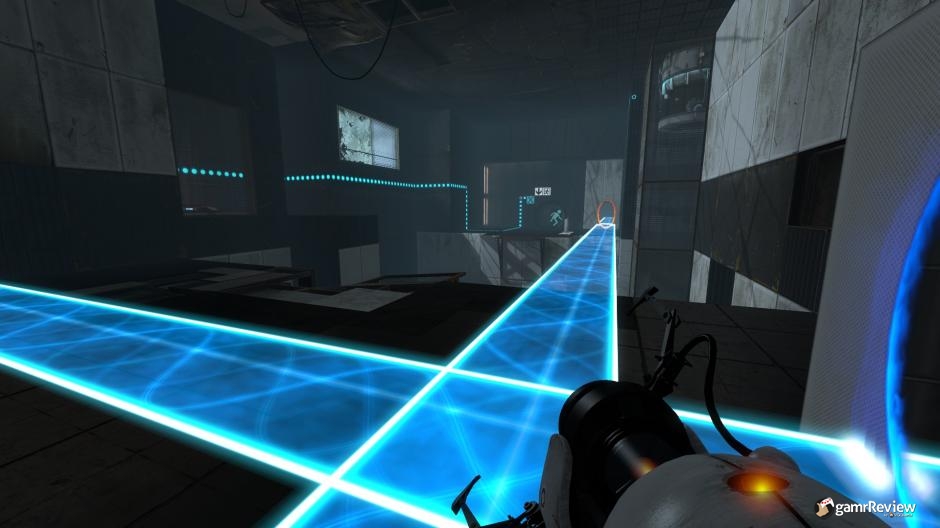
Later in the game you’ll also be introduced to gels. There are three gels: Repulsion Gel (blue), Propulsion Gel (orange), and Lunar Gel (white). Lunar Gel is the most basic; it paints a surface white, which is the color of surface you can place portals on. Repulsion Gel creates a surface you can bounce off of, while Propulsion Gel makes you accelerate while you’re running on it. The final new ingredient is the Excursion Tunnel. These are glowing, swirling particles that carry you along a straight path if you get in their beam. These beams can run through portals and can defy gravity along their path. Near the end of the game, ALL of these different tools work in concert creating really complex puzzles.
The rooms and tests grow into much larger, more complex challenges than were ever seen in the original Portal. The time spent outside of testing rooms is much greater as well, making some of the puzzles much more organic, forcing you to really look around and observe your surroundings to find the solution. Riding up an elevator only to realize you actually have to fall back down the elevator shaft in order to utilize the momentum for a gigantic leap was one of my favorites of these organic moments.
That’s all just in the single-player campaign. Portal 2 also features a robust cooperative campaign in which you and a friend (or stranger) play as two robots named Atlas and P-Body. This campaign is completely different since all the puzzles require two players to complete. I found this mode to be extraordinarily satisfying. Most cooperative multiplayer games are simply you and a friend playing together. Portal 2 really forces you to work together to accomplish anything at all.
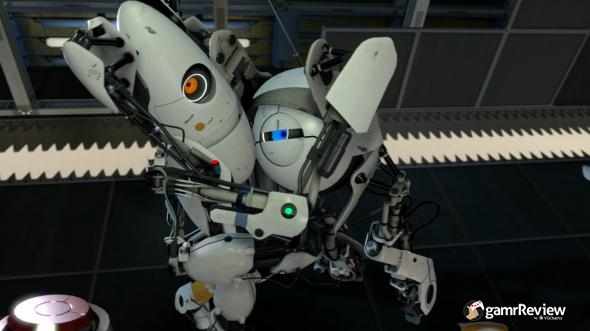
In addition to voice chat, the multiplayer also features a Ping tool, in which one player can point at something and create a temporary marker along with a pinging sound to tell their partner where to go or where to place a portal. These cooperative levels pushed the critical thinking even higher than the single-player campaign. My partner and I would often get one of us to the end of the test only to realize we still had the challenge of getting the other one there. Cooperative play can be done online or split-screen, including the option for a vertical or horizontal split.
The production values on Portal 2 are very high. The voice acting is some of the best I've heard in a game, with Ellen McLain returning to voice the frighteningly sarcastic GLaDOS as well as newcomers J.K. Simmons (Spider-Man, Juno) and Stephen Merchant (The Office – UK) lending their stupendous voice talents. The music is also top-notch, changing with the scenery and often ramping up as you get close to solving a puzzle.
The visuals are certainly great. While they won’t be going head-to-head with visual juggernauts like Crysis 2 or Mass Effect 2, they look great and it becomes apparent very quickly that Valve took no shortcuts with Portal 2. Early in the game, GLaDOS is actually rebuilding the facility as you’re playing through it, so the test rooms are alive and moving. These aren’t just the static, sterile test chambers you encountered in the original Portal. Walls move to replace damaged sections, half a room will be moved into position while suspended on a giant mechanical arm, indeed the entire Aperture Science facility feels like as much a character as GLaDOS or Wheatley. Never once did I see a screen tear or artifact, or notice a framerate drop.
There are certain things I expected before I began playing Portal 2. I expected a witty, funny game with great one-liners from GLaDOS. I expected head-scratching puzzles. I expected mind-bending physics. What I didn’t expect was what surprised me and pleased me the most: a compelling story. Portal 2’s story truly kept me on my toes, surprised me on multiple occasions, and even touched me a bit emotionally as I learned the history of Aperture Science as the story progressed. If the warped puzzles weren’t enough, the story kept me engaged right up to the jaw-dropping end.
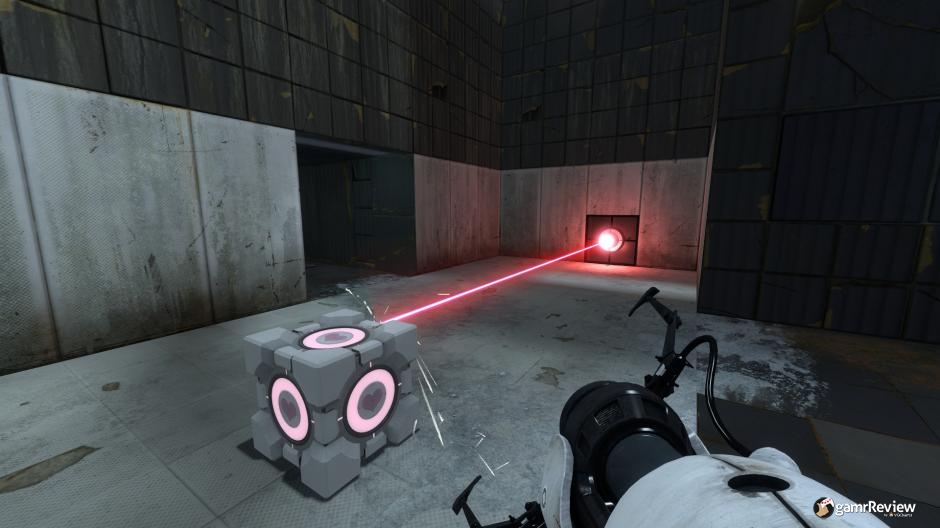
While the cooperative campaign doesn’t feature as deep a story as the single-player campaign, it still retains all the character. Atlas and P-Body have very anthropomorphic movements and actions, interacting with each other using a gesture wheel to perform simple things like high-fiving and dancing, to more complex movements like a game of paper-rock-scissors or taunting each other by removing each others’ parts. GLaDOS also has different interactivity with them, behaving more like a scolding (but still sardonic) mother hen rather than her outright loathing for the human character in the single-player campaign.
The menus in Portal 2 are very streamlined. Everything is clearly marked and easy to navigate. Best of all are the menus and progress display for the cooperative campaign. Once you’re in a cooperative game with a partner, you’re transferred to the hub, which is used to navigate to different test rooms and displays all the completion data for the two players. All this is in-game, accessed by looking around the hub room itself rather than some convoluted menus.
The single-player campaign will run most players 8-10 hours the first time through, longer if they really struggle with the puzzles, shorter (obviously) if they read too many walkthroughs. The cooperative campaign is a bit shorter at 6-8 hours. While the cooperative campaign allows you to select individual tests, the single-player campaign doesn’t allow this, which is a real shame. While the flow of campaign doesn’t lend itself to test selection for as much, it would have been nice.
Outside of the campaigns, there isn’t much else to do. There are developer commentary sections, which allow you to go into a room and interact with quote bubbles that trigger an audio track from a developer talking about the design process, but there are no extra challenges and no time trials for the varying tests. While there will supposedly be user-generated content on all platforms, there is currently no way to play it on any version. The Xbox 360 version also doesn’t feature the cross-platform play that will be featured on the PS3 and PC versions, while the PS3 version also comes with a free Steam copy of the game for PC and Mac, and the PC version is a good deal cheaper than the others. This creates a fairly large value differential between purchase platforms, and makes the 360 version the weakest of the bunch.
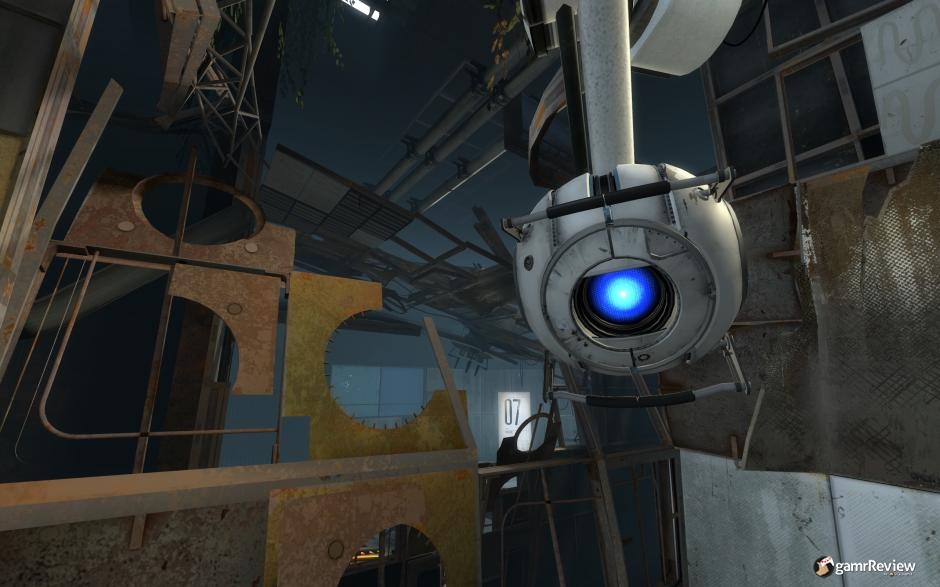
Portal 2 is one of those rare games that makes its predecessor completely obsolete. There are more puzzles, more characters, better graphics and sound, more variables in the puzzles, and a surprising story that went above and beyond my expectations. Unfortunately, once you’ve beaten both campaigns, there’s nothing left to do. Even with that shortcoming, however, Portal 2 is one of the most enjoyable gaming experiences I’ve had for quite a while.
Note: This game was played to completion on a review copy for Xbox 360.










| Total Sales |
0.01m
Japan |
1.41m
NA |
0.49m
Europe |
0.17m
Others |
2.08m
Total |
| 1 | n/a | 357,518 | 76,010 | 64,780 | 498,308 |
| 2 | n/a | 94,119 | 30,363 | 18,601 | 143,083 |
| 3 | n/a | 56,411 | 17,809 | 11,090 | 85,310 |
| 4 | n/a | 38,629 | 11,854 | 7,543 | 58,026 |
| 5 | 3,508 | 34,763 | 8,430 | 6,454 | 53,155 |
| 6 | 1,423 | 28,850 | 7,442 | 5,423 | 43,138 |
| 7 | 966 | 29,954 | 7,497 | 5,596 | 44,013 |
| 8 | 696 | 23,553 | 8,570 | 4,800 | 37,619 |
| 9 | 602 | 16,821 | 4,501 | 3,186 | 25,110 |
| 10 | 450 | 15,716 | 4,565 | 3,030 | 23,761 |
|
|
|
|
|
|
|
|
yo_john117
posted 24/09/2011, 08:58
Love Portal 2! deserves a better score than that though. And 1.17 sales!! Best number! Message | Report |
|
|
|
|
|
|
|
|
|